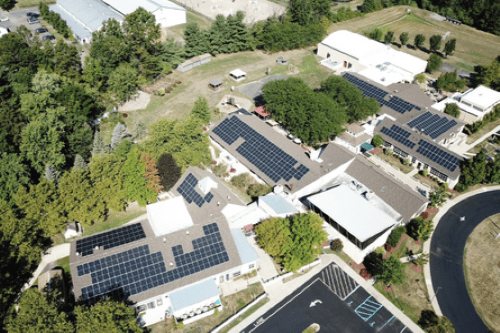“The land is where our roots are. The children must be taught to feel and live in harmony with the Earth.”
– Maria Montessori
As guides, it is vital that we help children understand the symbiotic partnership that exists between themselves and the world around them. Through small daily tasks and large global projects, even the very young child can begin to realize the profound impact they yield on the Earth.
Princeton Montessori School (PMonts), an AMS-accredited school in Princeton, NJ, has taken their role of sharing the value of the relationship between students and the Earth very seriously. As Gery Juleff, PMonts sustainability manager and ecology teacher says, PMonts recognized that they “needed to do more to live [their] values as a Montessori school, including caring for the planet and each other.”
Embracing environmental conservation and improvement efforts, PMonts has developed a unique plan that outlines their commitment to environmental sustainability. In addition to their already established projects including a Farm-to-School partnership, an onsite vegetable garden, and a sustainable composting system, PMonts has signed a solar energy agreement which included the installation of a solar array (a group of solar panels). These panels not only help to reduce energy costs for the school (around $500 – $800K over the course of the 20-year agreement), but also serve as an inspiration to students as PMonts does its part to fight against global climate change and contribute to the expansion of renewable energy. 85MT of CO2e is being offset in the local New Jersey electricity grid. Juleff reports as of late August 2022, [PMonts has] cheap, renewable energy supplying the majority of the school’s electricity needs.
However, it is important to remember that the benefits of sustainability efforts such as going solar are not just financial. As Juleff reminds us, taking these steps signals to the community that a program intends to live up to the Montessori principles that surround their responsibility to the environment and inspires others to do more as well.
Accepting the challenge to contribute to environmental responsibility and sustainability efforts may seem like a large feat, but it is deeply connected to the Montessori philosophy and one that is so important to the future of our planet. When asked about the importance of these projects, Juleff notes, “If there was any doubt before, the events of recent years—extreme weather events and the energy crises, as well as threats to biodiversity—have shown us that our children, and their children, will face enormous challenges with climate change, species loss and energy, so it [is] our school’s thinking that the current adults in charge and the next generation will need to do far more to change the direction that we are moving in.”
Tips for Implementing Solar Panels at Your School
Montessori schools and teacher education programs around the globe can replicate Princeton Montessori School’s sustainability efforts, accepting their responsibility to care for the planet and for each other. Here are five helpful steps from Juleff for programs hoping to implement solar projects of their own:
Educate Yourself and School Leadership
Learn about the benefits of “going solar.” Research the options in your area and share your findings with school leadership.
Form a Committee
Developing an ad hoc committee allows the work to be divided amongst many people. It is important to ensure that key decision-makers are active members of the committee.
Evaluate the Financial Costs
After making the initial decision to go solar, programs should consult with a number of suitable solar companies, asking them to provide initial proposals. Keep in mind that while there are challenges and the initial projected cost may seem large, the long-term financial benefits are plenty. The government (federal and state) also provides tax breaks and subsidies for solar arrays, meaning significant savings are possible. Depending on how it is financed, initial costs can be fairly low—Princeton’s costs were less than $10k.
Gather Support
Choose the best option from initial proposals based on factors that are important to the program. Get technical, legal, and engineering advice as needed when making this decision. Provide the recommendation to school leadership and be prepared to answer numerous questions. Know that there may be a degree of skepticism from decision makers, especially given the questionable reputation of some solar companies. Ensure you are entering an advantageous agreement that meets your program’s needs. Juleff and his team at PMonts found it helpful to hire a solar expert advisory team to ensure the contract was the best fit for their school.
Be Patient
Once the agreement is signed, the solar company will install the solar panels. However, it may be some time before the panels are “live” as the solar company needs the cooperation of the current energy company and an inspection. Take time to educate staff on how these projects will help them in their roles and will aid students. Reassure them that this will not be another burden for them and help them through the learning process. Be patient throughout all of these steps, knowing the long-term positive impacts are worth the work and worth the wait.
Gery Juleff wrote an informal note about the school’s experiences in installing solar and would be happy to talk to anybody who is interested in knowing more. His email is gery.juleff@princetonmontessori.org.


